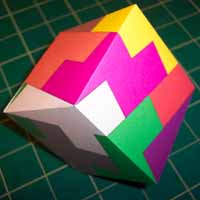Pentominic Surfaces
[Note: this webpage uses Java applets to illustrate the three dimensional nature of the figures discussed. If you don't see colorful objects that are mouse-draggable, then your web browser is not java enabled, and you are missing out... If you do have trouble viewing the applets, I would recommend you upgrade your web browser to the latest Firefox offered at Mozilla.org]Often, when people discuss pentominoes they are working with flat, two dimensional versions of the shapes, and the figures that are filled in or assembled are likewise two dimensional.
One variation to this is the notion of "solid pentominoes". If one assumes that the 12 pieces have a thickness equal to the unit cube's side length, then the pieces take on a third dimension (the I-pentomino is then considered to be constructed of 5 1x1 cubes stacked together in a line). One still retains the 12 shapes, they are now just blocks instead of thin "paper" (note that when extended to three dimensions, it is possible to create new shapes by adjoining five cubes in any direction -- these are usually referred to as 'penta-cubes' and are obviously a superset of the solid pentominoes). The 12 solid pentominoes also lend themselves to interesting assemblies -- now in three dimnesions. For example a 3x4x5 Box (60 unit cubes) can be constructed.
This article, however, is about a variation of pentominoes that I have not ever seen discussed. I will assume that the 12 pieces are flat (not solid), but I will also assume that they are made of a foldable material such as paper, and that the pieces may be creased along any edge where two of the unit squares meet.
This folding allows us to approach three dimensional figures, but instead of filling them with cubes, we are simply trying to cover the surface of the figures with folded versions of the pentominoes.
For example, below is a three dimensional shape that has a surface area of 60 unit squares. It is covered by the 12 pentominoes (you should be able to rotate the figure by click-dragging your mouse pointer over it).
| F | I | L | N | P | T | U | V | W | X | Y | Z |
|---|
The above shape is fairly simple. It would have been nice to have covered the surface area of a proper rectangular box, but no such box with a surface area of 60 unit squares exists.
Topologically speaking the next two figures are different than the first: they have one hole each. Both are shown to be solvable.
|
|
Having never seen a discussion of this variation of pentominoes, I have just started fiddling about with them. These are the only examples I have solved. I would welcome any contributions from others.
Obviously, finding potentially solvable figures, and then actually solving them, is a non-trivial matter. I used a "flat" pentomino solving computer program after mentally "unfolding" the target figure's surface. After the program found a solution, I refolded the answer into the 3D shape. I wrote the 3D viewing Java applet in a few hours.
The writing of a computer solver that would accommodate various surfaces (rather than just flat figures) is on my pentomino program "wishlist" (more on that in a later article).
Finally, here is a covered object with two holes in it.
Can anyone find one with three holes? For that matter, how many figures of surface area 60 with three proper holes even exist? Below is one possibility, but I have yet to figure out if it is coverable with pentominoes.
- Eric Harshbarger, 18 January 2005
Update (19 Jan 2005): Kate Jones of Kadon Enterprises, Inc. mentioned to me that in 1982 she was given a cube exactly covered by the 12 pentominoes. Michael Waitsman (1946-1995) gave it to her. At first I was questioning how this could be done since the pentominoes cover 60 squares, and a cube, with 6 faces (assuming of 3x3 unit squares each) would only require 54 squares total.
Quickly, though, I realized it might be possible if the edge lengths of the cube were not 3 units, but sqrt(10) units (the hypotenuse of a right triangle with legs 1 and 3 units). Sure enough, that's the trick. Such a configuration is mentioned in Golomb's Polyominoes; I had forgotten about it.
I soon made my own version out of folded paper. It is presented below (click for larger picture):

While this covering does not conform exactly to the guidelines I established above (this example does not fold along edges where unit squares meet), it is still an amazing configuration.
Update (20 Jan 2005): I have found a solution to the "3 ring" figure above.
Update (24 Jan 2005): Related to the first update above (concerning the covering of a cube with the 12 pentominoes): Today at a local coffeeshop I doodled around for about an hour and found a configuration of the 12 pieces which fold up into two separate cubes, each with side length of sqrt(5). Here is the example:
I have created a PDF file available for download (the color scheme is a bit different). Nethier the single cube nor two smaller cubes discussed in these updates are "nice"; they have corners at which a pentomino folds around and touches itself. There are known to be examples of a single cube covering where this "niceness" is obtained, and there might be such examples for the two smaller cubes, but since I have never seen the two cube problem discussed before, I'm not sure (and I have not taken the time to find one myself, yet).